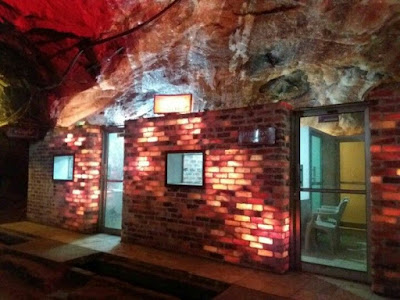On the onset of winter last year we decided we should visit
places that we would not in summers such as Multan. Few years back, on my transit
form Rawalpindi to Karachi via train I came across this beautiful city, as 12th
of Rabi-ul-awal was around the corner the city was radiating beacon of light in
dark of the night, the vision was serene and entrancing, it made me think of
all the gratitude that I have for the spirituality around me. So last year
in winters nearing month of Rabi-ul-Awal we decided to give it a go and it came
to us that just like other cities of Pakistan, Multan has its own tourist
attractions and fair share of places to visit. Multan has more to offer than it
appears to be.
History:
As it has been said in old sayings, “Multan is City of Saints Dust and Beggars”. It is famous for its
unique handicrafts, shrines, sufi music, parks and other cultural manifestations.
Today Multan has diverse culture both the combination of old and new Pakistani cultures.
History is really old which dates back to old Indus Valley
Civilization, existed 5000 years ago. Multan name came from pre-Muslim period
form an idol in Temple of the Sun God. It has faced many regimes and visits
form Sufis, arranging form Great Alexander visit in 326 BC to Mughal emperors. Lastly
British ruled it till independence.
Culture:
Multan is “Manchester”
of Pakistan as it is rich in ethnicity like Punjabi, Balochi, Sindh and
Pashtuns. No doubt the dominant religion is Islam. Most riveting aspect of
culture is “Derra” namely called “Bhettak”, it’s a place where friends
and neighbors will unite to talk about their day share happiness and sorrows. Multan
has variety in food, due to its ethnicity ranging from fast food, Chinese and Arabic
delicacies. While traditional renowned foods are Multani Mutton Chops, Multani Halwa (Sohan Halwa), Badami Kulfi, Paira,
Lassi, Doli Roti and Kachori.
Dominant language is “Saraiki”, the sweetest language of Pakistan and other dialects. Multan
is most famous for its handcrafts i.e. Blue
Pottery. The craft can be traced back to the city of Kashgar, China. Each pottery
piece is hand crafted and hand painted and is extremely beautiful and durable. The
art of it all is influenced by Persian art and can be seen in every piece.
At a Glance:
Our first destination on arrival was Ibn e Qasim Bagh. While visiting the place it gave us the
opportunity to relive in the residues of Qasim
Fort namely Multan Fort. Fort was
destroyed in reign of British.
We arrived at Walled
city of Multan through Haram Gate.
Walled city seemed both familiar and strange at the same time it was executing
more culture and rural vibes. Making our way to the shrine nearby, was the sight
of pigeons and gatekeeper of shrine feeding them adding more to the spirituality
of Multan.
First shrine we visited was Shrine of Sakhi Yahya Nawab,
son of Musa Pak Shaheed. The sight
was eye opening and in complete contrast with Walled city hustle, it’s like
shrine appeared out of nowhere, from its colorful bricked exterior to the
nature vested within was a calling and temptation.
The trance was broken eventually and we came across Musafarkhana, it seemed to be the best
possible place to stay in city. The three story building was made up of bricks
and the windows had colorful stained glass in wood craved frames all facing the
Sarafa Bazaar, a famous jewelry market.
We made our way to Chowk
Bazar though Main Street under all the canopies and came across Jain Mandir, people were oblivious to
its presence, to which we took the opportunity to have a look. The temple hall
was empty and you could clearly see the Hindu and English scripts in the tiles
telling mythical lore.
Moving ahead in bazar we finally came across the two most
famous shrines of Multan. Shrine of Shah Rukn-i-Alam and Shrine of Bhahudin
Zakariya. After taking riksha ride to Shrine
of Shah Rukn-i-Alam, we entered the shrine, the inside of tomb was dark and
cold. Man and women were praying and came forth to touch the tomb, place was
filled with air of reverence.
On our way to Shrine of Bhahudin Zakariya, we visited Clock Tower “Ghanta Ghar”. We were told
that it was government headquarters built in during British raj, the clock was
solar powered and stopped working while ago. Now government has converted it
into museum, Multan Museum. The museum
had collection of postage stamps, coins and medals.
Again passing by Qasim Fort we reached our final destination,
Shrine of Bhahudin Zakariya. The shrine
is the home of Shah Rukn-i-Aalm’s grandfather, he was the earliest preacher of
Islam. The structure was old and in contrast to Shrine of Shah Rukn-i-Alam but
it significance makes up for its beauty. The design was simple it had carved
wooden doors and walls were made of mud bricks.
The sun was about to set so I asked to stay for a bit before our
way home, as we sat around corner. I found myself lost to emphatic sounds of
Qawwali, and I knew I had eventually found what I came for, as group of men
near the entrance of tomb started to sing.
It is my heart’s desire to visit this place again and would suggest
that everyone must visit once in their life time even if it’s for the sake of
delicious Sohan Halwa!!!!. Here is something to push your over the edge.











































